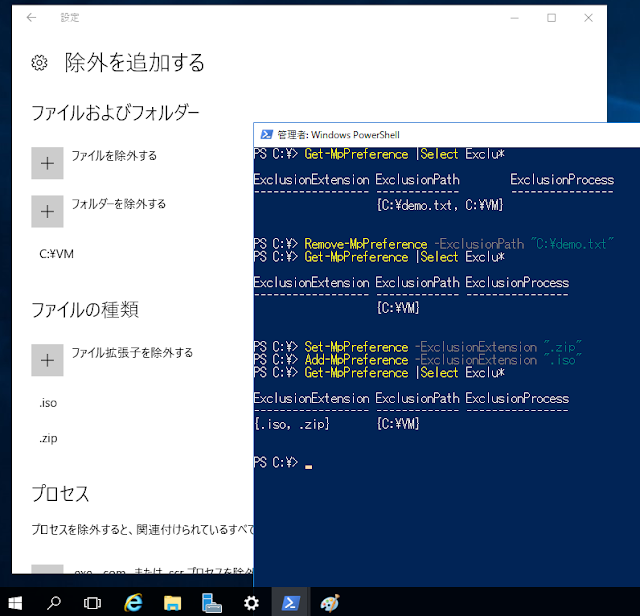[+ファイルを除外する][+フォルダーを除外する]は問題なく動きます。
追加済みの除外の[削除]ボタン、[+ファイル拡張子を除外する][+.exe、.com、または .scr プロセスを除外する]はすべて無反応。
とりあえずの回避策としては、Get-MpPreference、Set-MpPreference、Add-MpPreference、Remove-MpPreference コマンドレットで除外の追加や削除ができます。
Windows 10 Anniversary Update の場合、[削除]ボタン、[+ファイル拡張子を除外する][+.exe、.com、または .scr プロセスを除外する]をクリックすると、[除外の削除][除外の追加]の小さ目のダイアログ ボックスが表示されます。
この実体は、C:\Windows\System32\SystemSettingsAdminFlows.exe のようです。SystemSettingsAdminFlows.exe は Windows Server 2016 にも存在するのですが、Windows Server 2016 の場合、設定アプリ(SystemSettings.exe) から呼び出されている形跡なし。
なお、Windows Server 2016 と Windows 10 Anniversary Update の Windows Defender には、自動除外 (Automatic exclusions) という機能があって、既定で有効になっているので、例えば Hyper-V の役割がインストールされているなら、既定のパスや Vmms.exe とか Vmwp.exe とかがんばって除外設定しなくても勝手にやってくれています(Get-MpPreference の DisableAutoExclusions が $false (既定) のときの具体的な自動除外設定は以下に) 。
Automatic exclusions for Windows Defender
[URL]
https://docs.microsoft.com/ja-jp/windows/threat-protection/windows-defender-antivirus/configure-server-exclusions-windows-defender-antivirus




リンク先が下記に変わったようです、ご参考まで。
返信削除https://docs.microsoft.com/ja-jp/windows/threat-protection/windows-defender-antivirus/configure-server-exclusions-windows-defender-antivirus